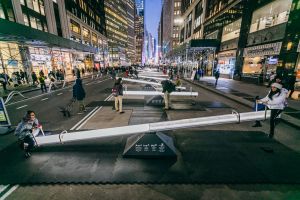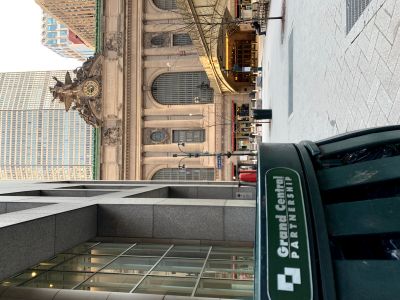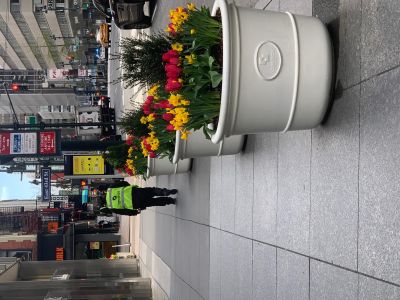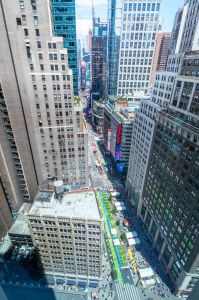Presented By: Partner Insights
In The Wake of COVID-19, New York’s BIDs Help Keep Their Neighborhoods Thriving
By Partner Insights May 18, 2020 9:35 am
reprints
For a perfect example of just how important BIDs and neighborhood associations are to New York City businesses, look no further than the Downtown Alliance’s Small Business Rental Assistance Grant.
Announced at the end of April, the grant is providing $800,000 to downtown businesses to help them pay rent in the face of losses related to the COVID-19 crisis.
“The Alliance has long worked to nurture the growth of local retail and that focus will continue to drive our recovery efforts,” said Downtown Alliance President Jessica Lappin. “There is not one storefront business in New York City that has been spared by COVID-19. Every one of them is struggling. We are stepping up to do what we can to help our stores keep their lights on.”

The grant, a mixture of redirected money from other areas of the Alliance’s budget and contributions from Brookfield Properties, Silverstein Properties and the Howard Hughes Corporation, will provide $10,000 to various small businesses in the area — just one example of how BIDs step up both in times of crisis and during business as usual.
At the beginning of March, before we had any real indication of how much our city was about to change, Barbara Blair, president of the Garment District Alliance, reflected on the biggest challenge before her organization at the time: Thanks to a December 2018 zoning change the Alliance had helped champion, side streets in the Garment District were finally open to businesses outside of the declining garment manufacturing sector.
“That was the biggest sea change for us over the past year,” Blair said. “You have this incredible stock of Class B and C office space on the side streets in the district, which was now finally available to other businesses. We have a lot of businesses that are very interested in coming here.”
This promoting of neighborhood change was perfectly indicative of the importance of New York City’s Business Improvement Districts (BIDs) and neighborhood associations in the pre-COVID-19 era.
In recent years, the zoning change was just one indication of the Garment District Alliance’s value to its district.
One Alliance priority, as with many of New York’s BIDs, was the area’s beautification. BIDs employ staff to handle sanitation, ensuring garbage is removed from the streets promptly, and also spearhead art projects and other visual enhancements.
In early January, the Garment District Alliance unveiled “Impulse,” an art installation on Broadway between 37th and 38th Streets consisting of 12 massive, 16-foot-by-24-foot illuminated seesaws. As people rode them, they played music.
“It was the most successful thing we’ve done in the neighborhood in 25 years. People loved them,” said Blair. “For the first time, we had an attraction on Broadway that was appealing not only to the tenants in the neighborhood, but also to visitors to New York City.”

The Alliance has also worked with the city’s Department of Transportation to turn more streets into pedestrian plazas and to remove unused pay phones that attracted an unsafe element.
The Grand Central Partnership is another of the city’s BIDs providing crucial support to its local business community.
“Pershing Square Plaza was first imagined in the master plan for the Midtown East neighborhood, created as part of the Grand Central Partnership’s origination 30-plus years ago, and is now realized as a permanent pedestrian plaza,” said Alfred C. Cerullo, the Partnership’s president and CEO.

“We are also coordinating and helping lead a stakeholder-driven project dubbed Friends of the Centerline that is endeavoring to reimagine the Park Avenue malls,” he said.
Like the Garment District Alliance, the Grand Central Partnership also played a key role in rezoning — in this case, the Midtown East Rezoning, which passed in 2017 — and the Partnership also launched events like the Summer Solstice Music Festival (SSMF), which, Cerullo said, was “styled after Paris’ Fetes de la Musique, and brings live music to the plazas, steps, and pocket public spaces along Park Avenue.”
A BIDs support for its neighborhood can take many forms. To support local businesses pre-COVID, the Downtown Alliance sponsored a Digital Innovation Grant that awarded $10,000 each to two small businesses per year to assist in their digital marketing efforts. Past winners have included the coffee shop Boundless Plains, the cafe B & Co., and Grand Street Jewelers.
Of course, many of the BIDs’ pre-COVID plans and ambitions are now in limbo, as the full effect of the COVID-19 pandemic comes into view.
But here, in the midst of one of the worst crises in the city’s history, the BIDs show just how crucial they are to the areas they support.
Speaking to the BID presidents again in late-April, we find them faced with a very different set of challenges. Now, the BIDs are doing everything they can to help area businesses survive.
In addition to situational extras like the Downtown Alliance’s Rental Assistance Grant, each of the BIDs continues to provide their traditional essential services.
“We are continuing to perform our core public safety and sanitation services, which have been deemed essential services, in support of both our neighborhoods and of those businesses that are still operating,” said Cerullo. “We feel that continuing to provide these services also helps maintain a sense of stability in our commercial districts. We’ve also been reaching out to our businesses to provide any information that could be helpful to them regarding relief programs or new regulations. We’ve created a page on our website with that sort of support information, and another page that lists what businesses are open and are offering takeout [or] delivery in the neighborhood.”
“A great deal of thought is going into what kind of support will be most effective for struggling Lower Manhattan shops, restaurants and bars,” said the Downtown Alliance’s Lappin. “On the streets, our Public Safety officers have been keeping an eye on the neighborhood while doing rounds to confirm business closures, while our sanitation crews have been disinfecting surfaces, removing litter, and emptying trash and recycling units. They even took advantage of the quiet time to power-wash our major retail corridors.”
As for Blair, she began talking to local manufacturers once the crisis kicked in about shifting production to much-needed medical equipment.

deemed essential services, in support of both our neighborhood and of the businesses still operating
here.” – Alfred C. Cerullo, III, President/CEO, Grand Central Partnership
“We still have a lot of factories in our neighborhood, so one of the things we’ve tried to do to keep people employed is to find out if they can make masks or gowns,” she said. “Now, there are a few factories on our website where you can order masks,” she said.
Blair has also been brainstorming ways to revive the area once it’s deemed safe for people to publicly engage again. Given that sidewalk cafes will be impractical due to the need for social distancing space, one idea being floated is for certain restaurants to annex parking spots in front of their stores (with cars being prohibited from driving on those streets) for outdoor cafe space.
“If you’re a restaurant that seats 100 people, we know you can’t seat that many people inside anymore,” she said. “But if you can have 25 seats out among the local parking spots, with the restaurant responsible for keeping it clean and providing their own tables and chairs, they could brand it in their own way, and it would be an extension of their indoor space,” she said.
If there’s one thing giving these BID presidents hope for New York City’s future, it’s seeing the city’s resiliency up close in the face of disaster. Asked about reasons for hope, all had ready responses.
Cerullo mentioned local businesses going out of their way to help others, including “Berkeley College donating medical supplies, and Sweetcatch Poke, Prova Pizzabar, and Zucker’s Bagels providing food to frontline workers.”
Lappin spoke about Harry’s Italian, which kept its locations open “not only to keep their staff working, but to support the community that built their business.” Brothers Frank and Salvatore Buglione and their partners sought out other local business owners, and together they’ve arranged to match donations to serve first responders at NYPD’s 1st Precinct, Engine 4 and Ladder 15 on South Street, and NewYork-Presbyterian Lower Manhattan Hospital.”

For Blair, the perseverance that will return New York to its rightful glory is baked in, as coming back from tragedy is part of the strength that makes New York the greatest city in the world.
“New York and the people that choose to be here have an undeniable resilience, and also a tremendous goodwill toward each other in times like this,” she said. “If you look at how retailers are supporting health care workers and how neighborhoods are supporting restaurants, the resiliency of New Yorkers and the will to make this work is what will bring New York back.”



